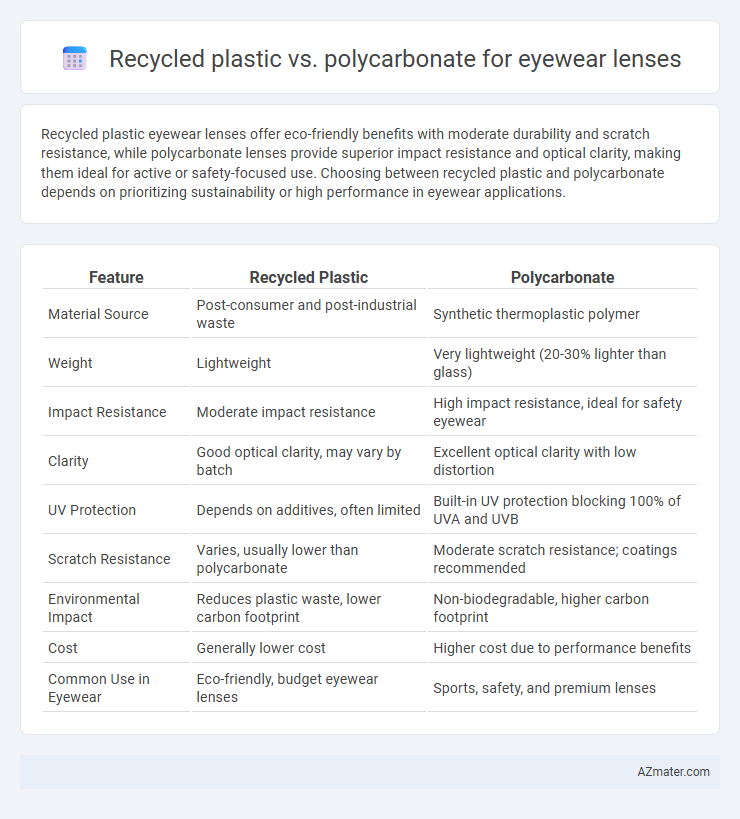Recycled plastic eyewear lenses offer eco-friendly benefits with moderate durability and scratch resistance, while polycarbonate lenses provide superior impact resistance and optical clarity, making them ideal for active or safety-focused use. Choosing between recycled plastic and polycarbonate depends on prioritizing sustainability or high performance in eyewear applications.
Table of Comparison
| Feature | Recycled Plastic | Polycarbonate |
|---|---|---|
| Material Source | Post-consumer and post-industrial waste | Synthetic thermoplastic polymer |
| Weight | Lightweight | Very lightweight (20-30% lighter than glass) |
| Impact Resistance | Moderate impact resistance | High impact resistance, ideal for safety eyewear |
| Clarity | Good optical clarity, may vary by batch | Excellent optical clarity with low distortion |
| UV Protection | Depends on additives, often limited | Built-in UV protection blocking 100% of UVA and UVB |
| Scratch Resistance | Varies, usually lower than polycarbonate | Moderate scratch resistance; coatings recommended |
| Environmental Impact | Reduces plastic waste, lower carbon footprint | Non-biodegradable, higher carbon footprint |
| Cost | Generally lower cost | Higher cost due to performance benefits |
| Common Use in Eyewear | Eco-friendly, budget eyewear lenses | Sports, safety, and premium lenses |
Introduction to Eyewear Lens Materials
Recycled plastic and polycarbonate are two prominent materials used in eyewear lenses, each offering distinct benefits in durability and environmental impact. Recycled plastic lenses provide an eco-friendly alternative by reducing waste and conserving resources while maintaining lightweight characteristics. Polycarbonate lenses boast high impact resistance and optical clarity, making them a preferred choice for safety and performance in eyewear.
Understanding Recycled Plastic Lenses
Recycled plastic lenses are produced from post-consumer plastic waste, offering an eco-friendly alternative with a reduced carbon footprint compared to traditional polycarbonate lenses. These lenses often maintain comparable optical clarity and impact resistance, while promoting sustainability through material reuse and decreased resource consumption. Understanding the benefits of recycled plastic lenses highlights their role in advancing environmentally responsible eyewear without sacrificing performance.
Exploring Polycarbonate Lenses
Polycarbonate lenses offer superior impact resistance and lightweight comfort compared to recycled plastic lenses, making them ideal for eyewear requiring high durability. Their inherent UV protection and optical clarity enhance safety and vision quality, outperforming most recycled plastic alternatives. Polycarbonate's advanced polymer structure provides better scratch resistance and longevity, crucial for daily eyewear use.
Environmental Impact: Recycled Plastic vs Polycarbonate
Recycled plastic eyewear lenses significantly reduce environmental impact by repurposing waste materials and lowering carbon emissions compared to polycarbonate production, which relies on petroleum-based resources and energy-intensive manufacturing. Biodegradability and recyclability of recycled plastics further minimize landfill contribution, while polycarbonate lenses often persist longer in ecosystems due to limited recyclability. Choosing recycled plastic for eyewear supports sustainable resource management and reduces environmental pollution associated with traditional polycarbonate lens production.
Optical Clarity and Visual Performance
Recycled plastic lenses offer a sustainable option with decent optical clarity but often fall short compared to polycarbonate lenses, which provide superior visual performance due to higher impact resistance and better light transmission. Polycarbonate lenses feature excellent anti-scratch and UV protection properties, ensuring sharp, clear vision ideal for eyewear applications. Optical clarity in polycarbonate lenses is enhanced by advanced coatings that reduce glare and improve contrast, making them the preferred choice for high-performance eyewear.
Durability and Scratch Resistance
Recycled plastic eyewear lenses offer moderate durability with improved environmental benefits but generally have lower scratch resistance compared to polycarbonate lenses. Polycarbonate lenses provide exceptional impact resistance and superior scratch-resistant coatings, making them more durable for daily wear and physical activities. For users prioritizing long-term durability and scratch resistance, polycarbonate remains the preferred material despite the sustainability advantage of recycled plastics.
Weight and Comfort for Daily Wear
Recycled plastic eyewear lenses offer a lightweight and eco-friendly alternative, reducing overall frame weight and enhancing comfort for prolonged daily wear. Polycarbonate lenses are known for their impact resistance and durability but tend to be slightly heavier than recycled plastic options, which may affect comfort during extended use. Choosing recycled plastic lenses can improve wearability without compromising environment sustainability, making them ideal for everyday eyewear.
Cost Comparison: Affordability and Value
Recycled plastic eyewear lenses typically offer greater affordability due to lower raw material and manufacturing costs compared to polycarbonate lenses, making them a cost-effective choice for budget-conscious consumers. Polycarbonate lenses, while more expensive, provide enhanced impact resistance and optical clarity, delivering higher value through durability and performance. Evaluating cost versus long-term benefits helps consumers decide between the economical recycled plastic and the premium, impact-resistant polycarbonate options.
Sustainability and Eco-Friendly Practices
Recycled plastic eyewear lenses significantly reduce environmental impact by diverting plastic waste from landfills and lowering carbon emissions during production compared to virgin polycarbonate lenses. Polycarbonate, while offering high durability and impact resistance, typically relies on petroleum-based raw materials, leading to a larger ecological footprint. Integrating recycled plastic into eyewear lenses promotes sustainability through resource conservation and supports circular economy principles within the optical industry.
Choosing the Right Lens Material for Your Needs
Recycled plastic lenses offer eco-friendly benefits and lightweight comfort, ideal for everyday wearers prioritizing sustainability and affordability. Polycarbonate lenses provide superior impact resistance and UV protection, making them the preferred choice for sports and safety eyewear. Selecting the right lens material depends on balancing durability, environmental impact, and specific use-case requirements.

Infographic: Recycled plastic vs Polycarbonate for Eyewear lens
 azmater.com
azmater.com